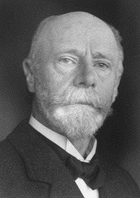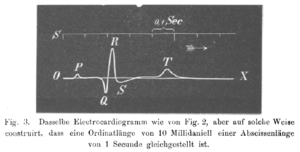A Concise History of the ECG
The history of the ECG goes back more than one and a half century

1850-1900
In 1843 Emil Du Bois-Reymond, a german physiologist, was the first to describe "action potentials" of muscular contraction. He used a highly sensitive galvanometer, which contained more than 5 km of wire. Du Bios Reymond named the different waves: "o" was the stable equilibrium and he was the first to use the p, q, r and s to describe the different waves. [1] However, in his excellent paper on the 'Naming of the waves in the ECG' Dr Hurst credits Einthoven for being the first to use PQRS and T.[2]
In 1850 M. Hoffa described how he could induce irregular contractions of the ventricles of doghearts by administering electrical shock. [3]
In 1885 Chauveau was the first to describe complete heart block in a horse while observing ventricular beats without movement of the atrial auricles.
In 1887 the English physiologist Augustus D. Waller from Londen published the first human electrocardiogram. He used a capillar-electrometer. [4][5]
The dutchman Willem Einthoven (1860-1927) introduced in 1893 the term 'electrocardiogram'. He described in 1895 how he used a galvanometer to visualize the electrical activity of the heart. In 1924 he received the Nobelprize for his work on the ECG. He connected electrodes to a patienta showed the electrical difference between two electrodes on the galvanometer. We still now use the term: Einthovens'leads. The string galvanometer (see Image) was the first clinical instrument on the recording of an ECG.
1900-1950
In 1905 Einthoven recorded the first 'telecardiogram' from the hospital to his laboratoy 1.5 km away.
In 1906 Einthoven published the first article in which he described a series of abnormal ECGs: left- and right bundlebranchblock, left- and right atrialdilatation, the U wave, notching of the QRS complex, ventricular extrasystoles, bigemini, atrialflutter and total AV block. [6]
1950-2000
2000-
References
-
Du Bois-Reymond, E. Untersuchungen über thierische Elektricität. Reimer, Berlin: 1848.
- Hurst JW. Naming of the waves in the ECG, with a brief account of their genesis. Circulation. 1998 Nov 3;98(18):1937-42. DOI:10.1161/01.cir.98.18.1937 |
-
Hoffa M, Ludwig C. 1850. Einige neue versuche uber herzbewegung. Zeitschrift Rationelle Medizin, 9: 107-144
-
Waller AD. A demonstration on man of electromotive changes accompanying the heart's beat. J Physiol (London) 1887;8:229-234
-
Waller AD. Introductory Address on The Electromotive Properties of the Human Heart. Brit. Med J, 1888;2:751-754
-
Einthoven W. Le telecardiogramme. Arch Int de Physiol 1906;4:132-164
-
Chauveau MA. De La Dissociation Du Rythme Auriculaire et du Rythme Ventriculaire. Rev. de Méd. Tome V. - Mars 1885: 161-173.
-
Einthoven W. Über die Form des menschlichen Electrocardiogramms. Pfügers Archiv maart 1895, pagina 101-123
-
Marey EJ. Des variations electriques des muscles et du couer en particulier etudies au moyen de l'electrometre de M Lippman. Compres Rendus Hebdomadaires des Seances de l'Acadamie des sciences 1876;82:975-977
- Márquez MF, Colín L, Guevara M, Iturralde P, and Hermosillo AG. Common electrocardiographic artifacts mimicking arrhythmias in ambulatory monitoring. Am Heart J. 2002 Aug;144(2):187-97. DOI:10.1067/mhj.2002.124047 |

